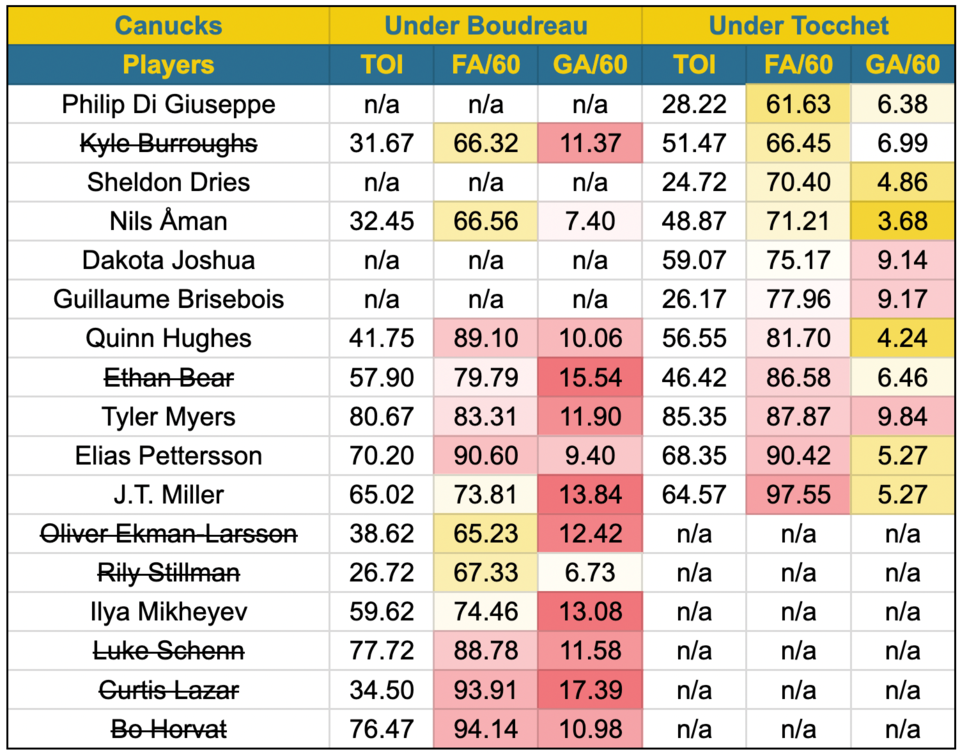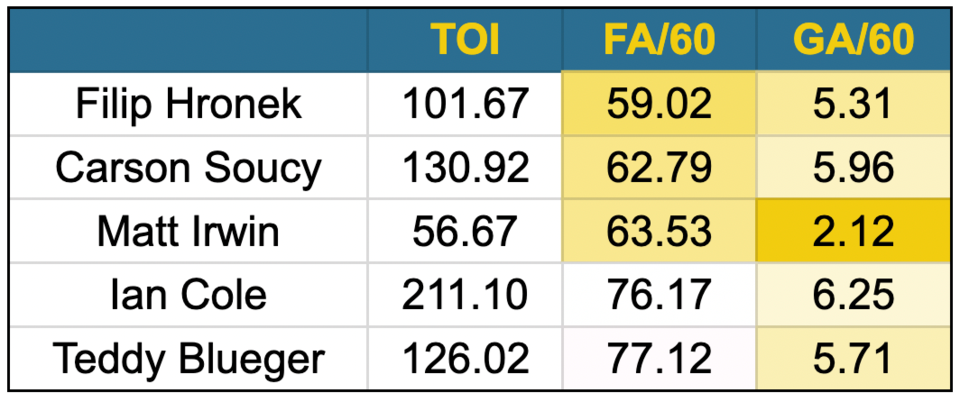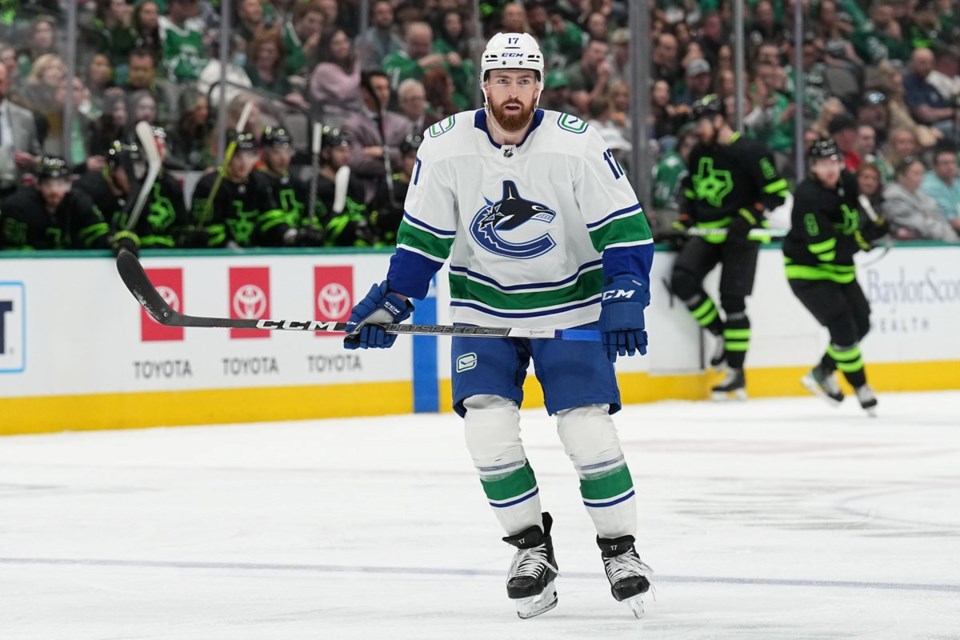The Vancouver Canucks managed to avoid setting a new record for futility on the penalty kill last season, but they still had the worst penalty kill percentage in the league.
The Canucks’ 71.6% penalty kill finished dead last in the NHL but was mitigated somewhat by 15 shorthanded goals. That meant their actual goal differential while shorthanded was just 26th in the NHL. That’s still not good, but their minus-54 was still well clear of the league-worst Anaheim Ducks at minus-77.
Still, the Canucks’ management team led by Patrik Allvin clearly wasn’t satisfied with the improvements the team made under new head coach Rick Tocchet. Allvin clearly prioritized penalty-killing prowess in the players they have acquired via trade and free agency.
Canucks completely overhauled their PK personnel
Filip Hronek was a regular on the Detroit Red Wings penalty kill and had the lowest rate of power play goals against on the team.
Carson Soucy was third among Seattle Kraken defencemen in shorthanded ice time and was on the ice for the seventh-lowest rate of expected goals against among NHL skaters with at least 100 minutes at 4-on-5.
Ian Cole led all Tampa Bay Lightning skaters in shorthanded ice time and Teddy Blueger led all Pittsburgh Penguins forwards in shorthanded ice time per game.
Even Matt Irwin, ostensibly signed to be the Canucks’ seventh defenceman, was outstanding on the penalty kill last season. Although he didn’t play as much as the Canucks’ other acquisitions, he had the lowest rate of power play goals against in the entire NHL among players who played at least 50 minutes at 4-on-5.
That definitely seems like a pattern.
Combine those five acquisitions with some of the departures and it’s clear there will be a complete overhaul of the Canucks’ penalty-killing personnel.
Seven of the Canucks’ regular penalty killers from last season, each of whom averaged at least one minute per game on the penalty kill, are gone, leaving via trade, free agency, or buyout: Oliver Ekman-Larsson, Bo Horvat, Luke Schenn, Ethan Bear, Kyle Burroughs, Curtis Lazar, and Riley Stillman.
The question is whether that change in personnel will be enough to give the Canucks a legitimately good penalty kill.
It’s not just personnel, of course. The Canucks’ penalty kill was an utter disaster prior to the coaching change from Bruce Boudreau to Rick Tocchet, but it wasn’t much better in the early days under Tocchet.
That’s not really surprising: the assistant coach in charge of the penalty kill, Mike Yeo, didn’t change.
The team’s tactics on the penalty kill did change, however, moving from a wedge+1 to a diamond formation and, perhaps with some influence from new assistant coach Adam Foote, they became a lot more aggressive in the neutral zone and at the blue line.
Who was best on the Canucks' PK last season?
Here are the skaters who played at least 20 minutes at 4-on-5 under Boudreau and Tocchet. The two statistics are unblocked shot attempts, aka. Fenwick, against per 60 minutes (FA/60) and goals against per 60 minutes (GA/60) coloured according to the NHL average, with gold being good and red being bad.

Three of the five players with the highest rate of power play goals against — Lazar, Bear, and Ekman-Larsson — are gone, while J.T. Miller made improvements under Tocchet and Ilya Mikheyev will hopefully improve once he’s not playing with a torn ACL.
Tocchet has said he wants to use Miller and Elias Pettersson less on the penalty kill despite their plethora of shorthanded goals, and that’s probably a good choice. The two forwards were on the ice for the highest rate of unblocked shot attempts against under Tocchet and would probably benefit from being used as the second penalty kill unit, so they can face either the opposition’s second power play unit or a tired first power play unit.
In terms of internal options on the penalty kill, Nils Åman was among the Canucks’ better penalty killers all season. That bodes well for him holding onto the fourth-line centre role, though it remains to be seen if he can be the type of player who is first over the boards on the penalty kill.
Philip Di Giuseppe was solid as well on the penalty kill under Tocchet and likely has an inside lane to making the Canucks’ roster given how much Tocchet seems to like him.
Tyler Myers led the Canucks in shorthanded ice time. He shouldn’t.
Canucks' new additions have plenty of PK experience
Fortunately, the Canucks’ additions should prevent that from happening again. Between Hronek, Soucy, and Cole, the Canucks have defencemen that can take over from Myers.

All five of the Canucks’ additions are at least average in FA/60 and above average in GA/60. Hronek, in particular, was outstanding in a secondary role with the Detroit Red Wings — his 59.02 FA/60 was sixth among all defencemen who played at least 100 minutes at 4-on-5, behind only Jaccob Slavin, Brent Burns, Mackenzie Weegar, Jake McCabe, and Charlie McAvoy.
If Hronek can put up similarly strong results as a primary, first-over-the-boards penalty killer on the right side, that will radically reduce the number of minutes Myers plays on the penalty kill.
Cole’s experience as a go-to penalty killer is likewise invaluable and, assuming he plays on the left side on the penalty kill, should reduce the minutes Quinn Hughes has to play. A Cole-Hronek pairing could become the Canucks’ top penalty-killing pairing on defence.
Irwin is an intriguing addition as well. It's unlikely that he can possibly repeat his league-best GA/60 on the penalty kill from last season, but it seems like the Canucks can at least be confident that he can contribute on the penalty kill when he's in the lineup.
Blueger is the only significant addition at forward but he has experience playing on a number one penalty-killing unit in Pittsburgh. He’s been above 50% in the faceoff circle the past two seasons and will likely be expected to face top power play units and relegate Pettersson and Miller to the second PK unit.
Blueger’s penalty-killing resume is solid: among the 86 forwards who have played at least 300 minutes on the penalty kill, Blueger’s 5.41 GA/60 is seventh best. J.T. Miller’s 10.77 GA/60 is 86th.
Demko staying healthy is vital to the PK
We shouldn’t neglect to mention the most important penalty killer: the goaltender.
The penalty kill didn’t really improve significantly until Thatcher Demko returned from injury.
Demko had a brutal .731 save percentage on the penalty kill before he got injured, as he struggled to deal with the dangerous cross-seam passes given up by the skaters in front of him and gave up some uncharacteristically soft goals to boot.
When he returned, however, Demko was back to his usual game-stealing self, with a solid .884 save percentage on the penalty kill to go with a .930 save percentage at 5-on-5 that would rank as one of the best in the league. Part of the reason for the improvement was the Canucks cutting down on cross-seam passes but Demko was also far more dialed in than he was to start the season.
While improvements in front of Demko will be essential, there’s no way for the penalty kill to excel without Demko at the top of his game. Keeping him healthy and focused will be key.




